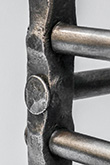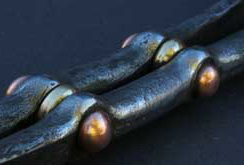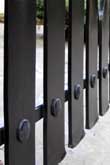"... Verdigris; where engineering becomes art ..."
Whilst rivets have traditionally been used by
blacksmiths to make strong and secure joinery, they can also serve as a design feature in their own right.
Holes are first punched or drilled
in the pieces of metal to be joined. These are then clamped together
and a rivet inserted through the holes. One end of the rivet is
supported by a heavy piece of metal called a bucking bar and
the other end is then hammered flat, or domed over,
to about one and a half times the width of the rivet body. A rivet
is usually inserted hot and the hammering causes it to swell up
inside the holes which takes up any slack. Additionally, the
rivet will shrink as it cools down and this causes it to pull together
the pieces being joined. As a result, a rivet makes a very strong
and tight joint.
Many forms can be used for rivet heads, ranging from domed through to
hammered flat but they can also be shaped in very expressive ways as this bed
frame shows. Rivets can be used very effectively
when they contrast with the pieces
of metal to be joined.


